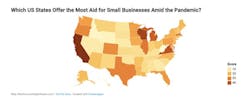Paycheck Protection Program Deadline Extended, Borrowers Now Have 5 Years to Pay Off Loans
Congress voted to extend the second round of Paycheck Protection Program (PPP) loans through Aug. 8 after the House passed the last minute bill without objection late Wednesday night. Previously, the Senate also voted unanimously for the extension, and President Trump is expected to sign the bill.
The first PPP deadline was set to expire on June 30, days before Congress would adjourn for a two-week recess.
Before the deadline was extended, the U.S. Small Business Association released new guidance for PPP loans on June 25, 2020. Small business owners now have five years to repay loans from the Paycheck Protection Program as well as more flexibility in qualifying for forgiveness, according to the SBA.
Thanks to the Paycheck Protection Program Flexibility Act of 2020 passed earlier this month, PPP loans issued after June 5, 2020, have a maturity of five years. Before this, small businesses had two years to pay any unforgiven portions of the loans.
Although this new time frame automatically applies to borrowers with loans issued after June 5, remodelers that have obtained a loan before the new date are not out of luck: If the borrower and the lender mutually agree, the lender can extend the maturity of previously issued loan to five years.
Covered period extended from eight weeks to 24 weeks
Additionally, the new law extends the covered period of loan forgiveness from eight weeks after the date of the loan disbursement to 24 weeks, which the SBA says provides “substantially greater flexibility for borrowers.” During this period, payroll costs will determine the amount of loan forgiveness available to a business. Every borrower qualifies for the 24 weeks of coverage, but those with loans issued before June 5th can use an eight weeks period.
Small businesses that adhere to the guidelines set out by the SBA can have their loans forgiven based on the following terms:
"The loan will be fully forgiven if the funds are used for payroll costs, interest on mortgages, rent, and utilities (due to likely high subscription, at least 60% of the forgiven amount must have been used for payroll),” the SBA says on its website. “Loan payments will also be deferred for six months. No collateral or personal guarantees are required. Neither the government nor lenders will charge small businesses any fees.”
Borrowers must apply for forgiveness. Though there is no requirement to submit a forgiveness application to receive a PPP loan, businesses that do not submit one within 10 months of approval must begin paying principal and interest after that period is over, according to JD Supra, which distributes news, commentary, and analysis from leading lawyers & law firms.
As of June 26, 2020, the SBA reports that there are 4,767,284 approved loans, totalling $517,913,219,743 distributed by 5,458 lenders. The average loan amount is $108,639.
Didn’t get in on the first round of PPP loans? The second round of applications, which debuted on April 27, 2020, is expected reopen due to the extended deadline once President Trump has signed the bill.
Need more than a PPP Loan? Small business support amid the coronavirus pandemic varies by state
If a small business already has a PPP loan but needs more assistance, state financial assistance and loan programs can help the company stay afloat. To find out which states offer the best small business support beyond federal programs, BestAccountingSoftware.com crunched the numbers from SBA reports, Institute for Local Self-Reliance, the U.S. Chamber of Commerce, Deloitte, and Reuters.
Each state received a score from the software company based on the number of loans that have been or are still available, the allocation of federal funding, and their regulations for assistance--the higher the score, the better the prospects for small business financial assistance.
The top five states include California, Wisconsin, Virginia, Michigan, and Illinois. BestAccountingSoftware.com reports that these states have robust loan and grant programs available, while the bottom five states (West Virginia, Idaho, Wyoming, Delaware, and Utah) offer little to no state or local grants or loans.
“All five of the bottom states have offered little in the form of state or local grants or loans. West Virginia, Idaho, and Wyoming haven’t introduced any, while Delaware and Utah have a single loan scheme each,” the company reports. “None of them have offered tax deferrals for businesses either, nor did Utah offer suspensions on commercial evictions.”
BetterAccountingSoftware.com compiled its results into interactive maps.

